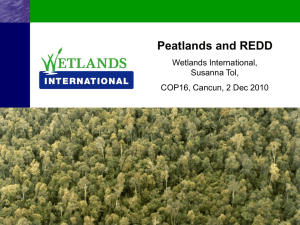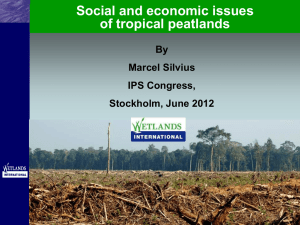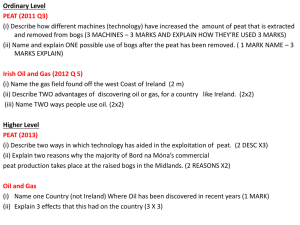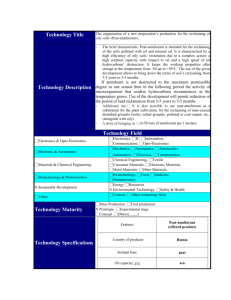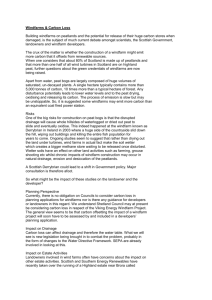Turetsky et al_Controls on global peat fires and consequences for
advertisement
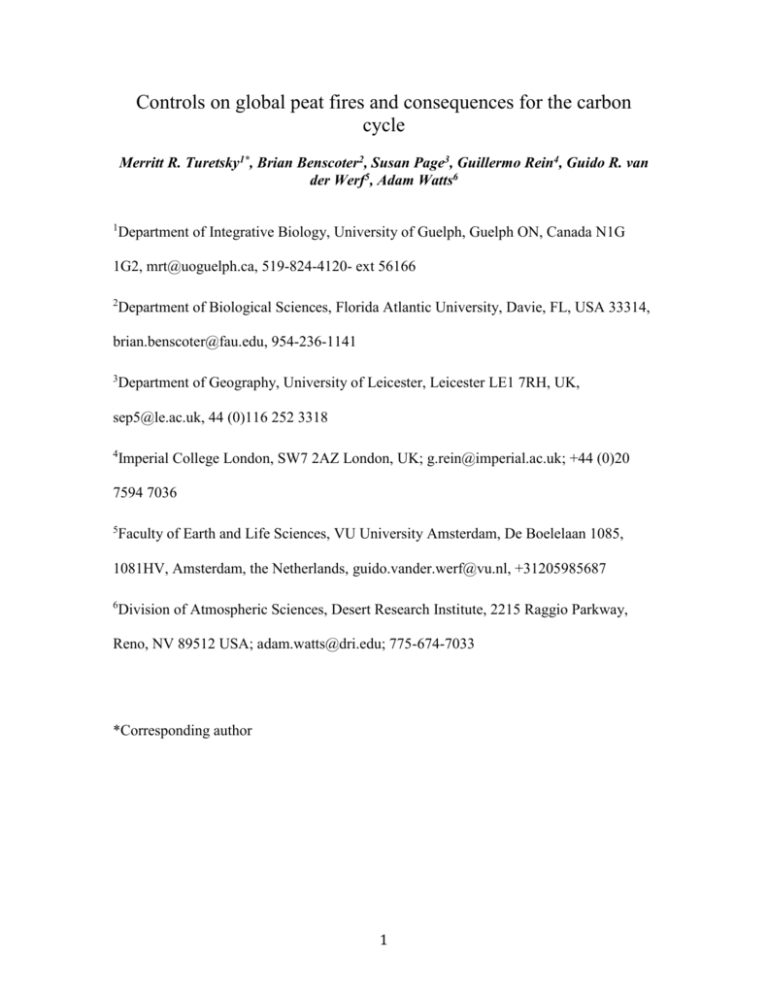
Controls on global peat fires and consequences for the carbon cycle Merritt R. Turetsky1*, Brian Benscoter2, Susan Page3, Guillermo Rein4, Guido R. van der Werf5, Adam Watts6 1 Department of Integrative Biology, University of Guelph, Guelph ON, Canada N1G 1G2, mrt@uoguelph.ca, 519-824-4120- ext 56166 2 Department of Biological Sciences, Florida Atlantic University, Davie, FL, USA 33314, brian.benscoter@fau.edu, 954-236-1141 3 Department of Geography, University of Leicester, Leicester LE1 7RH, UK, sep5@le.ac.uk, 44 (0)116 252 3318 4 Imperial College London, SW7 2AZ London, UK; g.rein@imperial.ac.uk; +44 (0)20 7594 7036 5 Faculty of Earth and Life Sciences, VU University Amsterdam, De Boelelaan 1085, 1081HV, Amsterdam, the Netherlands, guido.vander.werf@vu.nl, +31205985687 6 Division of Atmospheric Sciences, Desert Research Institute, 2215 Raggio Parkway, Reno, NV 89512 USA; adam.watts@dri.edu; 775-674-7033 *Corresponding author 1 1 Abstract 2 The global peat carbon pool exceeds that of global vegetation and is similar to the current 3 atmospheric carbon pool. Because fire is increasingly appreciated as a threat to peatlands 4 and their carbon stocks, here we review the controls on and effects of peat fires across 5 biomes. Peat fires are dominated by smouldering combustion, which ignites more easily 6 than flaming combustion and persists in wet conditions. In undisturbed peatlands, most of 7 the peat C stock typically is protected from smouldering, and resistance to fire has 8 increased peat carbon storage in boreal and tropical regions over long time scales. 9 However, drying as a result of climate change and anthropogenic activity lowers the 10 peatland water table and increases the frequency and extent of peat fires. The combustion 11 of deep peat affects older soil carbon that has not been part of the active carbon cycle for 12 centuries to millennia, and will dictate the importance of peat fire emissions to the carbon 13 cycle and feedbacks to the climate. 2 14 Peatlands are ecosystems that accumulate thick organic soil layers because of a long-term 15 imbalance in which plant production exceeds decomposition throughout the entire organic 16 soil column (Figure 1). Peatlands cover only about 2-3% of the Earth’s land surface, but 17 store around 25% of the world’s soil carbon (C)1. They are most abundant at northern high 18 latitudes (Figure 2A), where they cover approximately 4,000,000 km2 of land1 and store an 19 estimated 500 - 600 Gt (Gt = 1015) C. Tropical peatlands store an additional ~100 Gt C 20 across 400,000 km2, primarily in Southeast Asia1,2. Hence the global peat C pool exceeds 21 that of global vegetation (~560 Gt C) and may be of similar magnitude to the atmospheric 22 C pool (~850 Gt C)3. 23 Peat is defined as an organic soil composed of partially decayed plant remains with 24 less than 20-35% mineral content. Slow decomposition rates created by anaerobic 25 conditions are viewed as a necessary condition for peatland development4. Plant remains 26 are deposited into the upper peat layer, which often is located above the mean water table 27 for at least part of the year, and undergoes aerobic decomposition. Remaining organic 28 matter is buried and transferred to the saturated peat layer below the water table where 29 decomposition is minimal. Thus, water table depth is a key regulator of peatland 30 decomposition and peat accumulation rates. If warming or disturbance lowers the water 31 table in peatlands, removal of anaerobic constraints on decomposition will stimulate loss 32 of peat carbon to the atmosphere5. A lower water table also will stimulate the loss of peat 33 carbon via combustion during wildfires2,6, which we discuss in more detail in the sections 34 below. 35 36 Peatland vulnerability to burning 3 37 Due to high moisture contents, the bulk of peat soils in pristine peatlands are 38 naturally protected from burning, which facilitates the accumulation of peat over centuries 39 to millennia in both boreal and tropical settings7,8. In contrast, while a shallow peat layer 40 accumulates in many well-drained boreal forests, these soil organic layers are typically 41 consumed during wildfires, resulting in negligible soil C accumulation across multiple fire 42 cycles9. 43 As with all wildland fires, peatlands burn when an ignition event occurs in the 44 presence of fuel and the right conditions to support combustion. In low biomass systems, 45 such as grasslands, fuel load availability and continuity controls fire spread. However, in 46 high biomass systems such as peatlands, fires are controlled by heat transfer10 and water 47 content11. Peat fires generally are dominated by smouldering combustion 12, a flameless 48 form of combustion that occurs more readily than flaming combustion10. Smouldering fires 49 can persist under low temperatures, high moisture content and low oxygen concentrations13 50 and as a result can burn for long periods (e.g. weeks, months) despite rain events or changes 51 in fire weather12. While fast moving flaming fires can travel over 10 km h–1, the rate of 52 spread of smouldering can be as slow as 0.5 m per week14. Smouldering and flaming 53 combustion during wildfires often are coupled. For example, smoldering peat can provide 54 a pathway to a flaming fire even if the heat sources (embers or lightning) are too weak to 55 ignite a flame directly. 56 In general, the peat C stock is protected from deep smouldering because of 57 hydrologic self-regulation in peatlands15,16. The high porosity and storativity (storage 58 coefficient) of surface peat layers minimizes water table variability and helps peatlands to 59 maintain conditions too wet to sustain smouldering. If surface peat does dry and become 4 60 flammable, wet dense organic layers found deeper in the peat profile typically serve as a 61 fire barrier. However, when natural or anthropogenic disturbances interfere with 62 hydrologic self-regulation and allow further drying, deep peat becomes vulnerable to more 63 frequent or more severe burning. 64 Across some boreal regions, particularly continental North America, mean annual 65 burn area has more than doubled in the past several decades, associated at least in part with 66 regional warming17,18. Even during severe fire years, burning in undisturbed boreal 67 peatlands typically is limited to the upper 10-20 cm of peat19,20. Forestry, agriculture, peat 68 harvesting, and road construction in boreal regions all lead to peatland drainage, which can 69 greatly exacerbate the burning of peat. Experimental drainage of a Canadian fen increased 70 fire emissions nine-fold, resulting in release of more than 450 years' worth of peat 71 accumulation during a single fire6. 72 In the tropics, abundant and regular rainfall combined with a humid understory 73 microclimate ensures that water inputs usually exceed evapotranspiration losses from 74 peatlands, maintaining high peat moisture21. As a result, tropical swamps in their natural 75 state are fire resistant owing to moist microclimate and low-flammability soils. Prior to 76 large-scale settlement and agricultural conversion of peatlands, only occasional fires were 77 detected on peatlands in Southeast Asia, even during drought spells, and with a sufficient 78 time between fires to allow recovery of forest cover22. Human activities in the tropics, 79 including plantation development, agriculture, and logging, have made peatlands more 80 vulnerable to burning23. For example, disturbed peatlands in Southeast Asia are fire-prone 81 owing to the high amount of dry, flammable materials and the lower humidity that results 82 from a reduced tree canopy. Additionally, increased human access and activities increase 5 83 the number of accidental or intentional fire ignitions. As a result, drained tropical peats 84 tend to burn extensively. Fires consumed peat up to depths of 50 cm during the ENSO 85 events of 1997/98 and 200624,25. Drainage and logging in tropical peatlands also has 86 shortened fire frequencies, and repeated burning has further reduced the peatland carbon 87 stock26. 88 89 Fire and ecological feedbacks 90 Due to fire resistance, fire has not played a significant historic role in the ecology of tropical 91 peatlands. In contrast, wildfire plays an important role in the functioning of undisturbed 92 boreal peatlands. Fire in boreal peatlands initiates plant successional change, increases soil 93 temperatures, and increases nutrient availability similarly to burning in other 94 ecosystems27,28. Heterogeneous patterns in the combustion of peat promote biodiversity by 95 supporting the establishment of more species-rich pioneer plant communities27. Spatial 96 variation in combustion also influences the undulating hummocks and hollows that 97 characterize the ground surface of most northern peatlands. In part because of the water 98 use strategies of Sphagnum (peat mosses), hummock peat has greater water holding 99 capacity and burns less extensively than peat in hollows, which reinforces these 100 microtopographic features28,29. 101 Deeper burning of peat resulting from water table drawdown has consequences for 102 post-fire ecosystem function and succession in both boreal and tropical regions. Although 103 energy release from flaming fires is more intense than smouldering, active flaming 104 produces high temperatures at the ground surface for only a brief period of time, with 105 minimal heating of even shallow soil layers31. The longer duration of smouldering transfers 6 106 more heat to surrounding soils and plants than active flaming. As a result, smouldering 107 fires transfer heat deeper into the soil, and can lead to extensive fuel consumption that can 108 be two orders of magnitude larger than that in flaming fires12. Increased smouldering of 109 deeper peat as a result of water table drawdown will increase damage to heat-sensitive plant 110 roots and microorganisms such as ectomycorrhizae and bacteria32,33. These altered fire 111 effects are likely to be more long-lived in disturbed peatlands. Post-fire succession can 112 cause disturbed boreal and tropical peatlands to shift from nonflammable to more 113 flammable fuel types, increasing fire risk26. These post-fire shifts also are indicative of a 114 loss of hydrological regulation in these systems, which likely cause a diminishment of peat 115 accumulation even in the absence of repeated fires. 116 117 Carbon emissions from peatland burning 118 Due to the accumulation of peat and their role as a persistent global sink of 119 atmospheric CO2 throughout the Holocene, peatlands have had a net cooling effect on the 120 Earth's climate34. This is despite the fact that these systems also serve as a source of 121 methane34, which is produced by microbes under anaerobic conditions. However, increased 122 soil C losses from disturbed peatlands may have significant climate impacts in the future35. 123 From an atmospheric viewpoint, fires in undisturbed peatlands are most likely to be CO2 124 neutral because the combustion of surface peat influences carbon that is cycling rapidly 125 (i.e., combusted carbon is quickly re-sequestered by recovering vegetation). This type of 126 burning results in a near zero effect on atmospheric carbon over time scales of decades to 127 centuries36. However, the combustion of deep peat has the potential to affect older soil 128 carbon that has not been part of the active carbon cycle for centuries to millennia. If 7 129 increases in fire frequency or burn severity lead to deeper burning in peatlands, these fires 130 will no longer be carbon neutral, at least on time scales of centuries to millennia. 131 Perhaps as a harbinger of future emissions, widespread and deep burning peat fires 132 in Indonesia in 1997 and 1998 released approximately 0.95 Gt of carbon24,37, equivalent to 133 ~ 15 % of global fossil fuel emissions at that time. Peat fire emissions also have indirect 134 climate impacts. Smoke produced by peat smouldering leads to regional haze and reduced 135 light levels, which suppresses plant CO2 uptake39. Smoke from peat fires could have more 136 widespread influences, such as on marine ecosystems40. Smouldering is known to produce 137 larger emissions of CO and CH4, volatile organic compounds, polyaromatic hydrocarbons, 138 and particulate matter than flaming combustion. For example, tropical peat fires emit as 139 much as three to six times more particulate matter than grassland, forest, or plantation fires 140 per unit carbon combusted8. An understanding of the contribution of aerosols from biomass 141 burning to radiative forcing in general is limited3, and the lack of attention to aerosols from 142 peat fires creates a striking knowledge gap with respect to future global climate change41. 143 The quantity of peat fire-derived emissions and the amounts emitted under different 144 flaming and smouldering phases is poorly understood12 and represent important areas of 145 future research. 146 At regional to global scales, estimates of fire C emissions usually are derived from 147 coarse-scale models, typically at spatial resolutions of 0.50° or 0.25° (Figure 2), that have 148 not been specifically designed to estimate peatland fire emissions. Peatlands themselves 149 are difficult to map42, and as a result there are few remote sensing products that allow for 150 spatially explicit assessments of peatland abundance or the effects of wildfire on peatland 151 carbon dynamics. Smouldering fires also are inherently difficult to detect with spatial data 8 152 such as thermal anomaly maps, which often are used in wildfire detection43. For these 153 reasons, estimates of fire carbon emissions depend on rough indications of fire frequencies 154 (Figure 2) and cannot resolve the high spatial variability typically associated with peatland 155 fire dynamics. Despite these uncertainties, it is clear that peat fires have the potential to 156 contribute significantly to global emissions of greenhouse gases. 157 158 Current and future risks of peat fires 159 This review has highlighted a number of important areas in which tropical and 160 boreal peatlands differ in fire vulnerability. Low latitude peatlands, like those of Indonesia, 161 Malaysia, Peru, Brazil, and the Caribbean region, are juxtaposed with densely populated 162 urban areas. In these regions, drainage due to anthropogenic activities and increased 163 frequency of human-caused ignitions has converted many peatlands from fire-resistant to 164 fire-prone systems. In contrast, drier soils and increased lightning ignitions as a result of a 165 warming climate are the most important factors increasing the likelihood of northern high 166 latitude peat fires. The role of expanding human populations in this region is not well 167 understood. Independent of these anthropogenic factors, it seems likely that future climate 168 will increase the vulnerability of peatlands to fire at a global scale. In virtually all areas 169 where peatlands are abundant, relative humidity is expected to decrease during the burning 170 season (Figure 2C), which may increase the likelihood of peat fires. 171 Our synthesis of the current state of knowledge on peatland ecosystem carbon 172 fluxes indicates that losses via fire can exceed those due to enhanced decomposition in 173 disturbed boreal and tropical peatlands (Figure 1). Climatic or anthropogenic drying of 174 peatlands enhances microbial decomposition of organic soils and stimulates fire activity. 9 175 While drying in some boreal peatlands will stimulate tree growth and enhance total 176 vegetation C uptake, reduced moss productivity combined with a more frequent and severe 177 fire regime will diminish peat accumulation and long-term C storage. In the tropics, 178 anthropogenic drainage and deforestation reduces the vegetation carbon sink and shifts 179 vegetation towards more flammable fuels. Drying in peatlands also increases the depth of 180 belowground fuel combustion, releasing carbon that has been stored in soils for centuries 181 to millennia to the atmosphere, thus creating a positive feedback to the climate system 182 (Figure 1). These conclusions are limited by the current state of research, but clearly point 183 to the importance of fire to future peatland carbon balance. 184 The past decade of geoscience research has greatly improved our understanding of 185 the controls on peat fires, their effects on ecosystems, and feedbacks to climate. Increases 186 in peat fires also have landscape and health consequences that extend beyond the 187 geosciences. Because smouldering peat fires are difficult to suppress, land managers will 188 require new tools to respond to extreme fire danger situations in areas where peatlands are 189 prone to burning. Peat fire emissions cause diminished air quality44, resulting in respiratory 190 disease and human mortality45-47. In some cases, fire can cause a long-term change in the 191 environment, e.g. the thawing of the underlying frozen ground in permafrost peatlands, the 192 initiation of extensive peat erosion in upland temperate peatlands48 or replacement of 193 biodiverse forested peatlands in SE Asia by species-poor herbaceous communities26. If 194 these changes enhance peat drying and lead to the accumulation of flammable fuels, they 195 will increase fire frequencies and lead to even more severe burning of peat. Alternatively, 196 if vegetation regrowth decreases insolation and wind penetrance, increases in local 197 humidity could reduce peatland fire risk. Similarly, a reduction in woody fuels in favor of 10 198 sparse, discontinuous vegetation could limit the spread of wildland fires in peatlands. Due 199 to these uncertainties, there is a need for studies that address the ecology of peat fires, and 200 the role of peat fires in long-term Earth System processes. 11 201 References 202 1 203 204 4071-4085 (2012). 2 205 206 Yu, Z. Northern peatland carbon stocks and dynamics: a review. Biogeosciences 9, Page, S., Rieley, J.O. & Banks, C.J. Global and regional importance of the tropical peatland carbon pool. Global Change Biology 17, 798-818 (2011). 3 IPCC. Climate Change 2013. The Physical Science Basis. Working Group I 207 Contribution to the 5th Assessment of the Intergovernmental Panel on Climate 208 Change. Cambridge University Press. Cambridge, NY. (2013) 209 4 Belyea, L. R. & Clymo, R. S. Feedback control of the rate of peat formation. 210 Proceedings of the Royal Society of London: Biological Sciences 268, 1315-1321 211 (2001). 212 5 213 214 149 (2001). 6 215 216 Freeman C, Ostle J, Kang H. An enzymic latch on a global carbon store. Nature 409, Turetsky, M. R., Donahue, W. & Benscoter, B. W. Experimental drying intensifies burning and carbon losses in a northern peatland. Nature Comm 2:514 (2011). 7 Harden, J. W., Trumbore, S. E., Stocks, B. J., Hirsch, A., Gower, S. T., O'Neill, K. P. & 217 Kasischke, E.S. The role of fire in the boreal carbon budget. Global Change 218 Biology 6, 174-184 (2000). 219 8 Page, S. E., Wüst, R. A. J., Weiss, D., Rieley, J. O., Shotyk, W. & Limin, S. H. A 220 record of Late Pleistocene and Holocene carbon accumulation and climate change 221 from an equatorial peat bog (Kalimantan, Indonesia): implications for past, 222 present and future carbon dynamics. Journal of Quaternary Science 19, 625-635 223 (2004). 12 224 9 Johnston, J. F., Hollingsworth, T. N., Chapin, F. S. III & Mack, M. C. Changes in fire 225 regime break the legacy lock on successional trajectories in Alaskan boreal forest. 226 Global Change Biology 16, 1281-1295 (2010). 227 10 228 229 and Combustion Science 11, 277-310 (1985). 11 230 231 Ohlemiller, T.J. Modeling of smoldering combustion propagation. Progress in Energy Frandsen, W.H. Ignition probability of organic soils. Can. J. For. Res. 27, 1471–1477 (1997). 12 Rein, G. Smouldering Fires and Natural Fuels. Chapter 2, Fire Phenomena in the Earth 232 System – An Interdisciplinary Approach to Fire Science, pp. 15–34, C Belcher 233 (Wiley and Sons, DOI: 10.1002/9781118529539.ch2 2013). 234 13 Belcher, C. M . Yearsley, J. M., Hadden, R. M., McElwain, J. C. & Rein, G. Baseline 235 Intrinsic Flammability of Earth’s Ecosystems Estimated from Paleoatmospheric 236 Oxygen over the Past 350 Million Years. Proceedings of the National Academy of 237 Sciences 107, 22448-22453 (2010). 238 14 Rollins, M. S., Cohen, A. D. & Durig, J. R. Effects of fires on the chemical and 239 petrographic composition of peat in the Snuggedy Swamp, North Carolina. Int. J. 240 Coal. Geol. 22, 101-117 (1993). 241 15 Dommain, R., Couwenberg, J. & Joosten, H. Hydrological self-regulation of domed 242 peatlands in south-east Asia and consequences for conservation and restoration. 243 Mires and Peat 6, 1-17 (2010). 244 16 Whittington, P. N. & Price, J. S. The effects of water table draw-down (as a surrogate 245 for climate change) on the hydrology of a fen peatland, Canada, Hydrol. 246 Processes 20, 3589–3600 (2006). 13 247 17 Gillett, N.P., Weaver, A.J., Zwiers, F.W., & Flannigan, M.D. Detecting the effect of 248 climate change on Canadian forest fires. Geophysical Research Letters 31, 249 L18211. doi:10.1029/2004GL020876 (2004). 250 18 Kasischke, E. S. & Turetsky, M. R. Recent changes in the fire regime across the North 251 American boreal region—Spatial and temporal patterns of burning across Canada 252 and Alaska. Geophysical Research Letters 33, L09703, 253 doi:10.1029/2006GL025677 (2006). 254 19 Benscoter, B. W. & Wieder, R. K. Variability in organic matter lost by combustion in a 255 boreal bog during the 2001 Chisholm fire. Canadian Journal of Forest Research 256 33, 2509-2513 (2003). 257 20 Turetsky, M. R., Kane, E. S., Harden, J. W., Ottmar, R. D., Manies, K. L., Hoy, E. & 258 Kasischke, E. S. Recent acceleration of biomass burning and carbon losses in 259 Alaskan forests and peatlands. Nature Geoscience 4, 27-31 (2011). 260 21 Kelly, T.J., Baird, A.J., Roucoux, K.H., Baker, T.R., Honorio Coronado, E.N., Lawson, 261 I. T. & Rios, M. The high hydraulic conductivity of three wooded tropical peat 262 swamps in northeast Peru: Measurements and implications for hydrological 263 function. Hydrological Processes doi: 10.1002/hyp.9884 (2013). 264 22 Goldammer, J.G. Tropical wildland fires and global changes: prehistoric evidence, 265 present fire regimes, and future trends. Global Biomass Burning: Atmospheric, 266 Climatic, and Biospheric Implications, pp 83-91, JS Levine (MIT Press, 267 Cambridge, Massachusetts, 1992). 268 269 23 Langner, A. & Siegert, F. Spatiotemporal fire occurrence in Borneo over a period of 10 years. Global Change Biology 15, 48-62 (2009). 14 270 24 Page, S. E., Siegert F., Rieley, J. O., Boehm, H.-D.V., Jaya, A. & Limin, S. The 271 amount of carbon released from peat and forest fires in Indonesia during 1997. 272 Nature 420, 61-65 (2002). 273 25 Ballhorn, U., Siegert, F., Mason, M. & Limin, S. Derivation of burn scar depths and 274 estimation of carbon emissions with LIDAR in Indonesian peatlands. PNAS 106, 275 21213– 21218, doi:10.1073/pnas.0906457106 (2009). 276 26 Hoscilo, A., Page, S. E., Tansey, K. J. & Rieley, J. O. Effect of repeated fires on land- 277 cover change on peatland in southern Central Kalimantan, Indonesia, from 1973 278 to 2005, Int. J. Wildland Fire 20, 578–588 (2011). 279 27 Benscoter, B. W. & Vitt, D. H. Spatial patterns and temporal trajectories in bog ground 280 layer composition along a post-fire chronosequence. Ecosystems 11, 1054-1064 281 (2008). 282 28 Kettridge, N., Thompson, D. K., & Waddington, J. M. Impact of wildfire on the 283 thermal behavior of northern peatlands: Observations and model simulations, 284 Journal of Geophysical Research-Biogeoscience, 117, G02014 (2012) 285 29 Shetler, G., Turetsky, M.R., Kane, E., & Kasischke, E. S. Sphagnum mosses limit total 286 carbon consumption during fire in Alaskan black spruce forests. Canadian 287 Journal of Forest Research 38, 2328-2336 (2008). 288 30 Benscoter, B., Thompson, D., Waddington, J.M., Wotton, M., Flannigan, M., de Groot, 289 W., & Turetsky, M.R. Interactive effects of vegetation, soil moisture, and bulk 290 density on depth of burning of thick organic soils. International Journal of 291 Wildland Fire 20, 418-429 (2011). 292 31 Hartford, R.A. & Frandsen, W. When It's Hot, It's Hot... Or Maybe It's Not! (Surface 15 293 Flaming May Not Portend Extensive Soil Heating). International Journal of 294 Wildland Fire 2, 139–144. doi 10.1071/WF9920139 (1992). 295 32 Hart, S. C., DeLuca, T. H., Newman, G. S., MacKenzie, M. D., & Boyle, S. I., Post-fire 296 vegetative dynamics as drivers of microbial community structure and function in 297 forest soils. Forest Ecology and Management 220, 166-184 (2005). 298 33 Treseder, K. K., Mack, M. C. & Cross, A. Relationships among fires, fungi, and soil 299 dynamics in Alaskan Boreal Forests. Ecological Applications 14, 1826-1838 300 (2004). 301 34 Frolking, S. & Roulet, N.T. Holocene radiative forcing impact of northern peatland 302 carbon accumulation and methane emissions. Global Change Biology 13, 1079- 303 1088 (2007). 304 35 Frolking, S., Talbot, J., Jones, M., Treat, C.C., Kauffman, J.B., Tuittila, E.S. & Roulet, 305 N.T. Peatlands in the Earth’s 21st century climate system, Environmental Reviews 306 19, 371-296 (2011). 307 36 308 309 Trumbore, S. Radiocarbon and Soil Carbon Dynamics. Annual Review of Earth and Planetary Sciences 37, 47-66 (2009). 37 van der Werf, G. R., Randerson, J. T., Giglio, L., Collatz, G. J., Mu, M., Kasibhatla, P. 310 S., Morton, D. C., DeFries, R. S., Jin, Y. & van Leeuwen, T. T. Global fire 311 emissions and the contribution of deforestation, savanna, forest, agricultural, and 312 peat fires (1997–2009). Atmos Chem Phys. 10, 11707-11735 (2010). 313 38 Heil, A., Langmann, B. & Aldrian, E. Indonesian peat and vegetation fire emissions: 314 Study on factors influencing large-scale smoke haze pollution using a regional 315 atmospheric chemistry model. Mitigation Adaptation Strategies for Global 16 316 317 Change 12, 113 – 133, doi:10.1007/s11027-006-9045-6 (2006). 39 Davies, S.J. & Unam, L. Smoke-haze from the 1997 Indonesian forest fires: effects on 318 pollution levels, local climate, atmospheric CO2 concentrations, and tree 319 photosynthesis. Forest Ecology and Management 124, 137-144 (1999). 320 40 Jaafar, Z. & Loh, T-L. Linking land, air, and sea: potential impacts of biomass burning 321 and the resultant haze on marine ecosystems of Southeast Asia. Global Change 322 Biology DOI: 10.1111/gcb.12539 (2014). 323 41 Chakrabarty, R. K., Moosmüller, H., Chen, L.-W. A., Lewis, K., Arnott, W. P., 324 Mazzoleni, C., Dubey, M. K., Wold, C. E., Hao, W. M. & Kreidenweis, S. M. 325 Brown Carbon in Tar Balls from Smoldering Biomass Combustion. Atmos. Chem. 326 Phys. Discuss. 10, 6297-6300 (2010). 327 42 Frey, K. E. & Smith, L. C. How well do we know northern land cover? Comparison of 328 four global vegetation and wetland products with a new ground-truth database for 329 West Siberia. Global Biogeochemical Cycles 21, GB1016, 330 doi:10.1029/2006GB002706 (2007). 331 43 Tansey, K., Beston, J., Hoscilo, A., Page, S. E. & Hernandez, C. U. P. Relationship 332 between MODIS fire hot spot count and burned area in a degraded tropical peat 333 swamp forest in Central Kalimantan, Indonesia. Journal of Geophysical Research 334 113. DOI:10.1029/2008JD010717 (2008). 335 44 See, S. W., Balasubramanian, R., Rianawati, E., Karthikeyan, S. & Streets, D. G.: 336 Characterization and source apportionment of particulate matter ≤ 2.5 micrometer 337 in Sumatra, Indonesia, during a recent peat fire episode. Environmental Science 338 and Technology 41, 3488–3494 (2007). 17 339 45 Rappold, A. G., Stone, S. L., Cascio, W. E., Neas, L. M., Kilaru, V. J., Carraway, M. 340 S., Szykman, J. J., Ising, A., Cleve, W. E., Meredith, J. T., Vaughan-Batten, H., 341 Deyneka, L. & Devlin, R. B. Peat Bog Wildfire Smoke Exposure in Rural North 342 Carolina Is Associated with Cardiopulmonary Emergency Department Visits 343 Assessed through Syndromic Surveillance. Environ Health Perspect. 119, 1415– 344 1420 (2011). 345 46 Johnston, F. H., Henderson, S. B., Chen, Y., Randerson, J. T., Marlier, M., DeFries, R. 346 S., Kinney, P., Bowman, D. J. M. S. & Brauer, M. Estimated Global Mortality 347 Attributable to Smoke from Landscape Fires. Environ. Health Perspect. 120, 348 doi:10.1289/ehp.1104422 (2012). 349 47 350 351 1-23 (2002). 48 352 353 Sastry, N. Forest fires, air pollution and mortality in Southeast Asia. Demography, 39, Tallis, J. H. Fire and flood at Holme Moss: erosion processes in an upland blanket mire. Journal of Ecology 75, 1099-1130 (1987). 49 Yu, Z. C., Loisel, J., Brosseau, D. P., Beilman, D. W., & Hunt, S. J. Global peatland 354 dynamics since the Last Glacial Maximum. Geophys. Res. Lett. 37, L13402, 355 doi:10.1029/2010GL043584 (2010). 356 50 Giglio, L., Randerson, J. T. & van der Werf, G. R. Analysis of daily, monthly, and 357 annual burned area using the fourth-generation global fire emissions database 358 (GFED4). Journal of Geophysical Research: Biogeosciences 118, 317–328, 359 doi:10.1002/jgrg.20042 (2013). 360 361 All correspondence and requests for materials should be addressed to Merritt R. Turetsky 18 362 (mrt@uoguelph.ca). 19 363 Acknowledgements 364 We thank A. D. McGuire and M. Flannigan for comments on previous versions of this 365 manuscript. We also thank our numerous colleagues working in boreal and tropical 366 regions for their efforts and progress on the subject of peat fires. MRT is supported by 367 NSERC and NASA grants, GvdW is supported by European Research Council grant 368 280061. 369 370 Author Contributions 371 M.R.T. led this synthesis and all authors contributed to writing and ideas presented. 372 373 There are no competing financial interests. 374 375 20 376 Figure Legends 377 Figure 1. Drying and fires increase peat carbon loss to the atmosphere. Changes in 378 ecosystem carbon stocks in response to fire and drying scenarios in (A) North American 379 continental boreal peatlands, and (B) SE Asian swamps. Ecosystem carbon balance is the 380 difference between net CO2 uptake by plants (NPP) and CO2 loss to the atmosphere through 381 decomposition (Rh) and combustion (C). In undisturbed peatlands, peat accumulates 382 because the vegetation carbon sink exceeds soil carbon losses throughout the entire peat 383 column. Drying associated with climate warming or human activities can influence 384 peatland carbon balance by altering plant carbon uptake or losses such as decomposition 385 (Rh) and combustion (C). Changes in the amount of belowground fuels with drying or 386 drainage is denoted by the red line. Arrows depict the direction of carbon transfer, with 387 the length of the arrows indicating the magnitude of changes in flux over a 100-year period 388 relative to the undisturbed state. Cooling effects on climate are shown by blue arrows; 389 warming effects by red arrows. 390 391 Figure 2. Fire and climate dynamics in peatlands. (A) Global peatland abundance based 392 on multiple data sources49, (B) average fire return intervals based on satellite derived 393 burned area50 in 0.25 × 0.25° grid cells coinciding with the peatland abundance data, and 394 (C) average change in relative humidity in the peatland grid cells based on the multi-model 395 mean CMIP5 climate projections (http://cmip-pcmdi.llnl.gov/cmip5/) in 2081-2100 396 compared to 1991-2010. In all panels, insets show an enlargement of SE Asia for visual 397 purposes. 398 21 A. Con nental Boreal Peatlands Undisturbed B. Tropical Swamps Climate-Mediated Drying and Afforesta on Undisturbed Socially-Mediated Drying and Deforesta on NPP Rh Rh NPP NPP Rh Rh NPP C Ecosystem C Stock Ecosystem C Stock C 399 400 22 C 401 23

